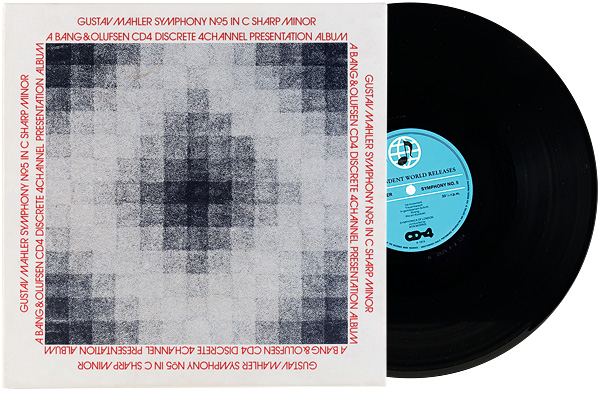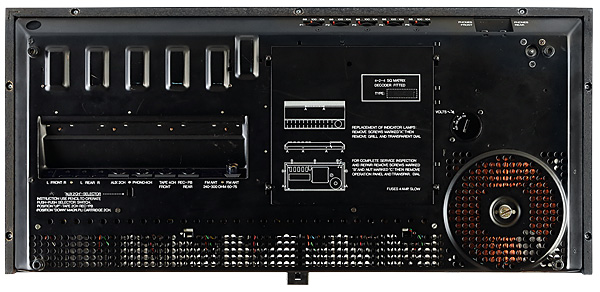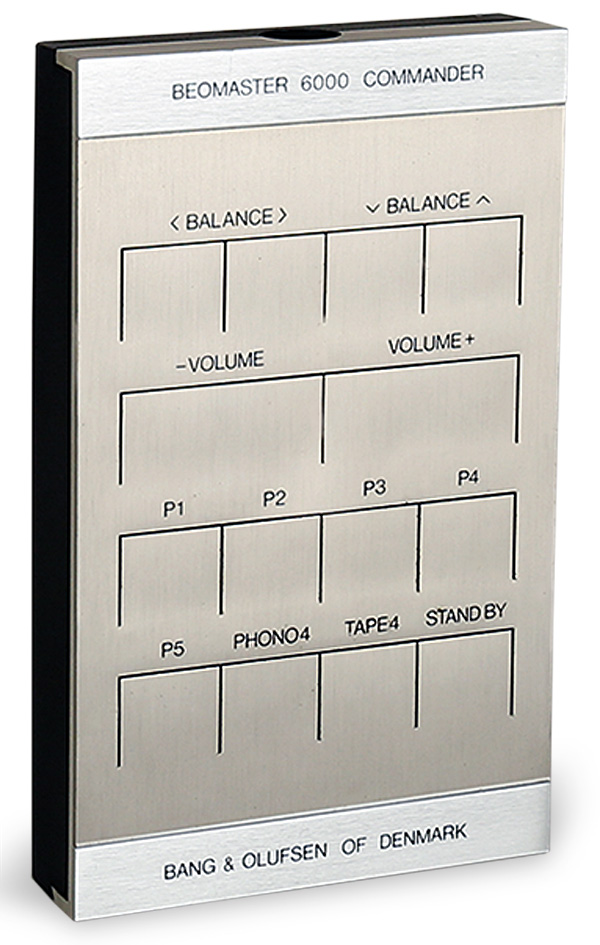B&O Beomaster 6000 4Ch Page 2
A further auxiliary socket is provided and this can be used to connect a stereo tape machine (playback and record) or a stereo turntable with a magnetic cartridge, there being a stereo MM phono stage built into the receiver. Selection is by a recessed push-button next to the socket. The slitted stainless steel operating panel works well, but the action of the keys is heavier than one might expect. The flush-mounted tuning wheel is a joy to use though, thanks to its smooth-running flywheel action.
The group of push buttons to the rear of the display panel control how the four amplifier channels are used. With nothing but 'front' and 'rear' pressed, stereo sources reach the front loudspeaker pair only, the rears remaining silent. Pressing 'stereo' routes the front signals to the rear as well, but the gain of the system is halved to keep the overall sound-level constant.

'Mono' does the same thing, but all the input channels are summed and sent to all the loudspeakers. 'Ambio' generates a Hafler effect (eg, the difference between the left and right signals) in the rear channels from stereo recordings. 'SQ' routes the front stereo inputs through the SQ decoder, and this is used when playing back an SQ LP. Meanwhile, surface noise exaggerated by the action of the Ambio and SQ modes can be suppressed with the 'Hi' filter, which in all but the first units produced works on the rear channels only.
![]() Tim Listens
Tim Listens
Interesting though it would be to audition this unit with period quadraphonic material there is something of a dearth of this to be found, especially CD4-encoded LPs. B&O did issue a CD4 recording of Mahler's Symphony No 5 as a free gift to 6000 buyers but to my ears it isn't the most exciting production in the world, either technically or artistically. SQ LPs are more common, but to get the measure of the big Beomaster I felt it was fairer to audition it as a stereo amplifier using CD as a source.
At a basic level the design gets a lot of things right. It sounds muscular and powerful, especially with two loudspeakers to drive. Tonally it is reasonably even too, with a pleasingly extended bottom end. Treble can seem a little curtailed, soft even, but not excessively so by the standards of its peers. The FM tuner too is every bit as good as it needs to be, accepting that it comes from a time before PLL stereo decoders and quartz-locked digital tuning became the norm. It would take a separate unit of the highest calibre to usefully improve on its performance.

Yet, for all its power, the Beomaster 6000 4Channel lacks the dynamics and excitement of the best amplifiers of the period. Compared to even the Beolab 5000 [HFN Dec '13] and Beomaster 4400 [HFN Jun '12] it doesn't have the arresting quality which makes the other two such a compelling listen. This is not evident with every type of music, however. Chopin's Nocturne No 20 [DG 447 098-2] has a beautifully liquid sound when played through the two front channels of this receiver, each note being exquisitely formed before falling from the loudspeakers. 'Polished' was a word that kept coming to mind, with any rough edges invisibly blended away.
A pleasing impression of space was also noted, albeit upon a soundstage I felt to be a little more constricted than I know to be possible. It was more up-tempo material that tripped the B&O up, tracks like 'Enjoy The Silence' by Depeche Mode [Violator; Mute CD Stumm 64] were not rendered with all the energy that I know to be there. This was not a matter of restricted bandwidth or lack of power, more that the presentation had an oddly two-dimensional quality that struggled to really project itself into the room.

Bass too became wayward at high listening levels, a not uncommon problem with some AC-coupled designs. Both these effects were limited in their extent, but I had hoped for better from B&O's costliest model, especially as some of the models that came before it performed so well. I doubt, however, that any of this will matter to prospective buyers. This is one of hi-fi's true design classics, a bold and elegant form which instantly made everything else look clumsy and out of date. For that you have to forgive it for not being the most exciting listen in the world.
Buying Secondhand
A common fault is the catastrophic failure of one or more of the power amps. This occurs when the central PCB warps and touches the sides of the steel trough where it is housed. All the transistors in the affected channels are usually destroyed and replacing them is made awkward by many of the connecting leads being seemingly too short. This can be avoided by adding a sheet of insulation in the trough between the track side of the PCB and the surrounding metalwork.
The rubber belts linking the clutches to the four gang potentiometers and displays that regulate the volume and tone functions are another weak point. Make new ones from O-ring cord and bond them into loops in-situ.

Hi-Fi News Verdict
Despite its rather relaxed sound the Beomaster 6000 4Channel wound its way into my heart. Ergonomically brilliant and technically rich – if dauntingly complex to repair – it is a superb collector's piece and a product to which the term 'state of the art' truly applied. Not without its frustrations when it comes to set-up and probably not for main system use, this iconic receiver is nonetheless an object of desire.
























































